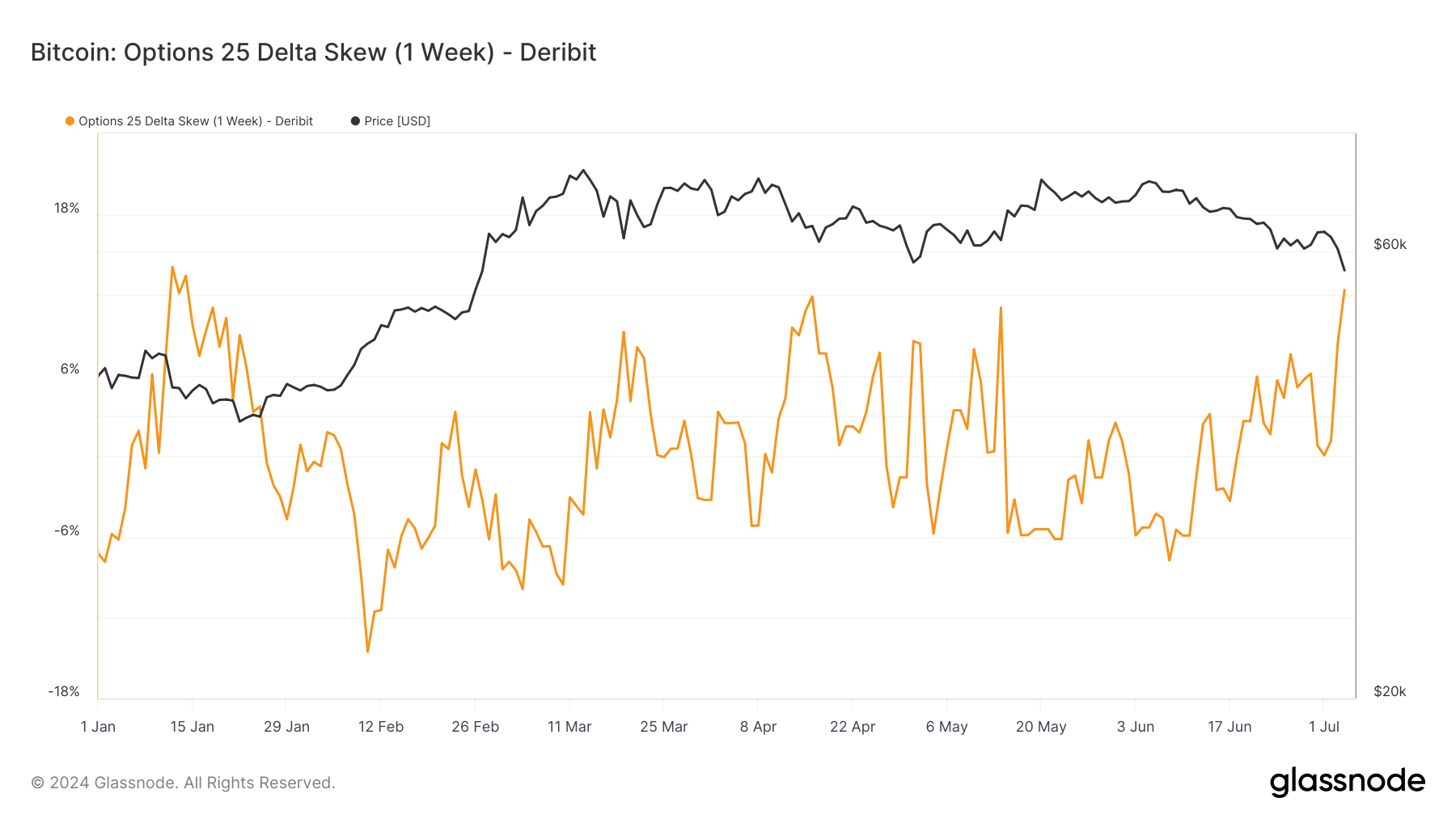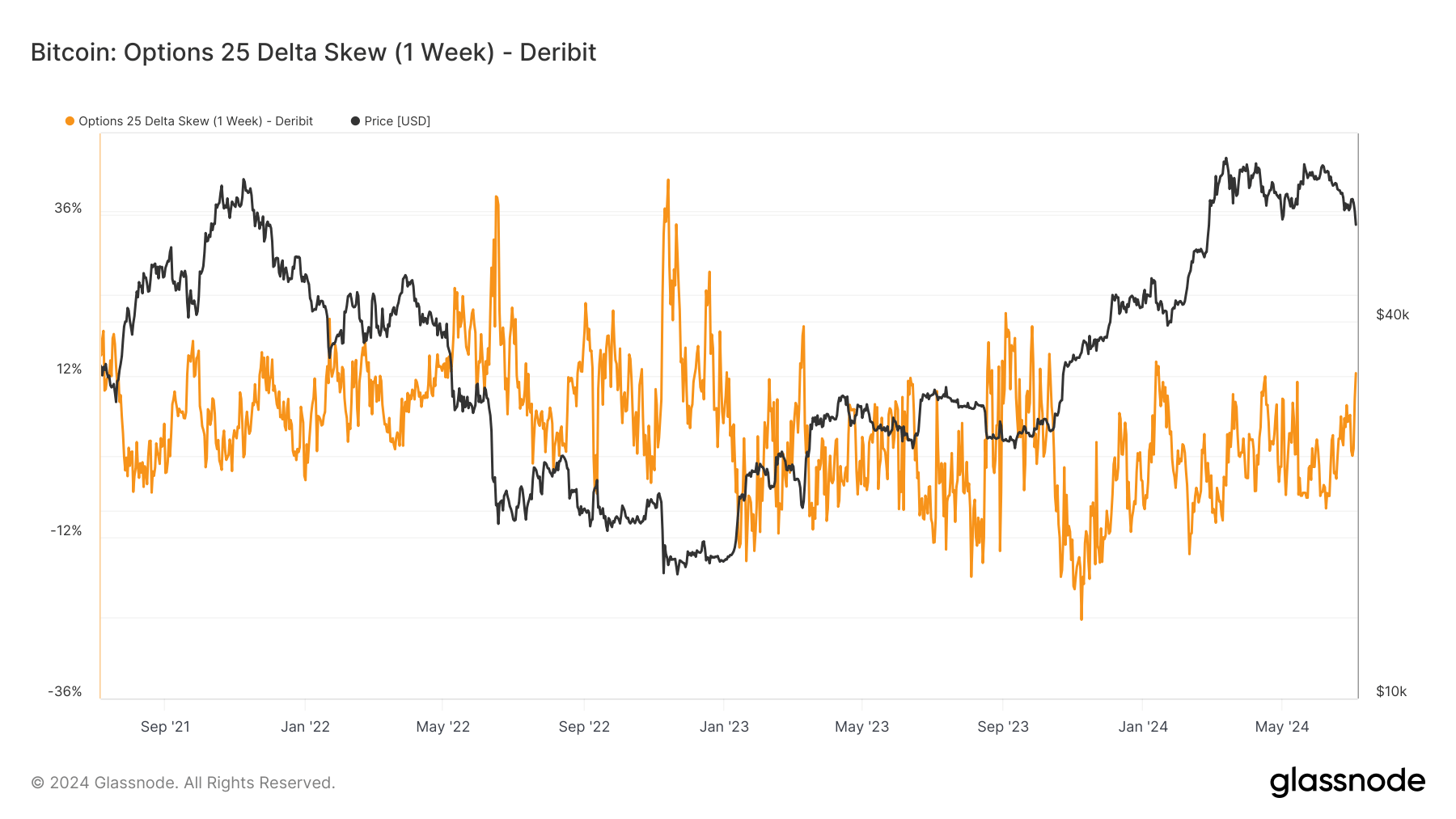Bitcoin’s 25 Delta Skew experiences sharp fluctuations amid correction
Onchain Highlights
DEFINITION:Skew is the relative richness of put vs call options, expressed in terms of Implied Volatility (IV). For options with a specific expiry, 25 Delta Skew refers to puts with a delta of -25% and calls with a delta of 25% to demonstrate this difference in the market’s perception of implied volatility. 25 Delta Skew is calculated as the difference between a 25-delta put’s implied volatility and a 25-delta call’s implied volatility, normalized by the ATM Implied Volatility. This metrics focuses on option contracts expiring in 1 week.
Bitcoin’s options market has seen significant volatility in the 25 Delta Skew over the past several months. The one-week 25 Delta Skew metric on Deribit, which tracks the difference in implied volatility between 25-delta puts and calls, has fluctuated widely. Since January, the skew has ranged from lows of around -15% to highs exceeding 15%, highlighting the shifting sentiment and market perceptions of risk among options traders.
The latest data shows a sharp increase in the skew due to Bitcoin current correction. Such swings often reflect traders’ shifts between bearish and bullish outlooks.

For much of 2021 – 2023, the skew’s movements were less pronounced, with fluctuations primarily between -12% and 12%.

This year’s heightened volatility could indicate increased uncertainty or differing hedging strategies post the April 2024 Bitcoin halving. The halving, which reduces miners’ rewards, typically influences long-term market conditions by constraining supply.
Understanding these dynamics is crucial for anticipating potential price movements, as options skew can serve as a leading indicator of broader market sentiment.
The post Bitcoin’s 25 Delta Skew experiences sharp fluctuations amid correction appeared first on CryptoSlate.
Bitcoin’s 25 Delta Skew experiences sharp fluctuations amid correction
Onchain Highlights
DEFINITION:Skew is the relative richness of put vs call options, expressed in terms of Implied Volatility (IV). For options with a specific expiry, 25 Delta Skew refers to puts with a delta of -25% and calls with a delta of 25% to demonstrate this difference in the market’s perception of implied volatility. 25 Delta Skew is calculated as the difference between a 25-delta put’s implied volatility and a 25-delta call’s implied volatility, normalized by the ATM Implied Volatility. This metrics focuses on option contracts expiring in 1 week.
Bitcoin’s options market has seen significant volatility in the 25 Delta Skew over the past several months. The one-week 25 Delta Skew metric on Deribit, which tracks the difference in implied volatility between 25-delta puts and calls, has fluctuated widely. Since January, the skew has ranged from lows of around -15% to highs exceeding 15%, highlighting the shifting sentiment and market perceptions of risk among options traders.
The latest data shows a sharp increase in the skew due to Bitcoin current correction. Such swings often reflect traders’ shifts between bearish and bullish outlooks.

For much of 2021 – 2023, the skew’s movements were less pronounced, with fluctuations primarily between -12% and 12%.

This year’s heightened volatility could indicate increased uncertainty or differing hedging strategies post the April 2024 Bitcoin halving. The halving, which reduces miners’ rewards, typically influences long-term market conditions by constraining supply.
Understanding these dynamics is crucial for anticipating potential price movements, as options skew can serve as a leading indicator of broader market sentiment.
The post Bitcoin’s 25 Delta Skew experiences sharp fluctuations amid correction appeared first on CryptoSlate.